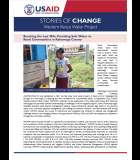AIDS, Population and Health Integrated Assistance – Kamili (APHIAplus – Kamili)
USAID Kenya supported an integrated service delivery model to improve the health of Kenyans across the country. The AIDS, Population and Health Integrated Assistance program, also known as APHIAplus, combined family planning, maternal/child health, malaria, nutrition, tuberculosis, and HIV/AIDS prevention, care, and treatment services to provide an integrated, high-quality, equitable approach to sustainable services at the national, county, and community levels. Integrating these activities through one program provided more effective communication and coordination with county health administrators. Seamless services and technical support at the local level ensured health workers address the unique needs of each geographic area across the country.
Activity Description
APHIAplus Kamili (Kamili means complete or perfect in Kiswahili), worked with the government and communitybased organizations to:
- Ensure access to quality health services and products. APHIAplus Kamili builds the capacity of health care providers to deliver high-quality health services. Specifically, the activity is helping people living with HIV/AIDS gain access to counseling and treatment, and is reducing child deaths through improved maternal and newborn child health services at health facilities.
- Improve the well-being of the poor and marginalized groups. At the community level, the activity is strengthening water, sanitation and hygiene activities and is improving the food security and economic well-being of households caring for orphans and vulnerable children. It assists orphans and vulnerable children with education, life-skills training, and suggestions for income generation.
Expected Outcomes
- Increase use of and demand for quality health services, products and information
- Scale-up and expand community and facility health service delivery especially to marginalized, poor and underserved populations
- Strengthen water and sanitation programs
- Strengthen food and economic security of households caring for orphans and vulnerable children
- Address gender issues in health services
- Design and implement effective behavior change communication programs
Actual Outcomes
- More than 400,000 individuals reached with HIV prevention interventions
- More than 1 million reached with HIV testing and counseling
- 34,152 patients on HIV care, 27,418 of whom are on life saving antiretroviral drugs
- 134,824 orphans and vulnerable children provided with interventions such as food and nutrition, housing and shelter, health services, and education
- More than 230,000 pregnant women received at least four antenatal care visits during pregnancy
- 99% of antenatal care clients reached with HIV testing services – prevention of mother to child transmission interventions have reduced mother to child HIV transmission from a high of 15% in 2009 to the current 5.7% at 12 months





